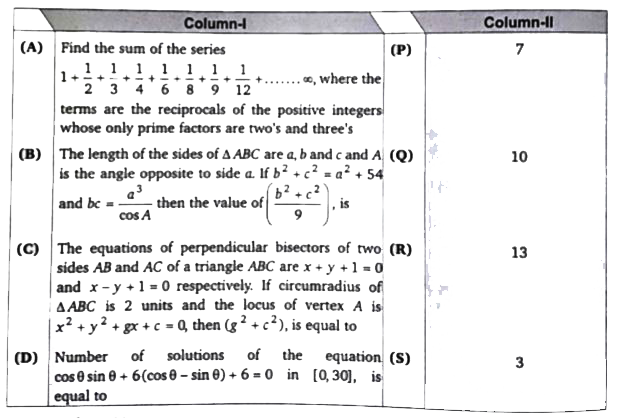a, b, c are the length of sides BC, CA, AB respectively of ΔABC satisfying log(1+ca)+loga−logb=log2.
Also the quadratic equation a(1−x2)+2bx+c(1+x2)=0 has two equal roots.
. Measure of angle C is :
30∘
45∘
60∘
90∘
The correct Answer is:D
Step by step video & image solution for a, b, c are the length of sides BC, CA, AB respectively of DeltaABC satisfying log(1+(c )/(a))+log a-log b=log2. Also the quadratic equation a(1-x^(2))+2bx+c(1+x^(2))=0 has two equal roots. . Measure of angle C is : by Maths experts to help you in doubts & scoring excellent marks in Class 12 exams.
Updated on:21/07/2023Topper's Solved these Questions
- SOLUTION OF TRIANGLESBOOK - VK JAISWAL ENGLISHCHAPTER - SOLUTION OF TRIANGLESEXERCISE - Exercise-4 : Matching Type Problems
2 Videos
- SOLUTION OF TRIANGLESBOOK - VK JAISWAL ENGLISHCHAPTER - SOLUTION OF TRIANGLESEXERCISE - Exercise-5 : Subjective Type Problems
9 Videos
- SOLUTION OF TRIANGLESBOOK - VK JAISWAL ENGLISHCHAPTER - SOLUTION OF TRIANGLESEXERCISE - Exercise-2 : One or More than One Answer is/are Correct
14 Videos
- SEQUENCE AND SERIES BOOK - VK JAISWAL ENGLISHCHAPTER - SEQUENCE AND SERIES EXERCISE - EXERCISE (SUBJECTIVE TYPE PROBLEMS)
21 Videos
- STRAIGHT LINES BOOK - VK JAISWAL ENGLISHCHAPTER - STRAIGHT LINES EXERCISE - Exercise-5 : Subjective Type Problems
10 Videos
Similar Questions

View SolutionIf the median AD of triangle ABC makes an angle π4 with the side BC, then find the value of |cotB−cotC|.
View SolutionIn ΔABC,∠A=60∘,∠B=90∘,∠C=30∘. Let H be its orthocentre, then :
(where symbols used have usual meanings)
View SolutionLet a,b,c,d be four distinct real number in A.P.Then the smallest positive vlaue of k satisfying 2(a−b)+k(b−c)2+(c−a)3=2(a−d)+(b−d)2+(c−d)3is_________
View SolutionIf the area of the quadrilateral ABCD whose vertices are A(1, 1), B(7, -3), C(12, 2) and D(7, 21) is Δ. Find the sum of the digits of Δ.
View Solution∫xdx(x−1)(x−2)equal
View SolutionIf a,b,c are the sides of triangle ABC satisfying log(1+ca)+loga−logb=log2. Also a(1−x2)+2bx+c(1+x2)=0 has two equal roots. Find the value of sinA+sinB+sinC.
View Solution[log(a2bc)+log(b2ac)+log(c2ab)] is equal to a. 0 b. 1 c. 2 d. abc
View SolutionIf log x(log x)/(a^(2)+ab+b^(2))=(log y)/(b^(2)+bc+c^(2))=(log z)/(c^(2)+ca+a^(2)) then x^(a-b)*y^(b-c)*z^(c-a)=
View SolutionIf a, b, c are positive real numbers then
11+logabc+11+logbca+11+logcab=
View SolutionIf logax,logbx,logcx are in A.P., where x≠1,thenc2=
View SolutionIf a=1+logxyz,b=1+logyzx,c=1+logzxy, then ab+bc+ca =
View Solutiona, b, c ar the length of sides BC, CA, AB respectively of ΔABC satisfying log(1+ca)+loga−logb=log2. Also the quadratic equation a(1−x2)+2bx+c(1+x2)=0 has two equal roots. Q. a, b, c are in :
View Solutiona, b, c ar the length of sides BC, CA, AB respectively of ΔABC satisfying log(a+ca)+loga−logb=log2.
Also the quadratic equation a(1−x2)+2bx+c(1+x2)=0 has two equal roots.
Q. Measure of angle C is :
View SolutionProve loga2bc+logb2ca+logc2ab=0.
View SolutionProve that
(vi) log(a2bc)+log(b2ca)+log(c2ab)=0
View Solution
